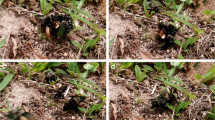Summary.
Both wingless worker-like queens, and dealated queens of the ponerine ant, Hypoponera nubatama, engage in egg-laying activities. Corresponding to the differentiation in female reproductives, males are also dimorphic, winged and ergatoid. In Japan, wingless reproductives appear mainly from late July to mid-August, while winged ones appear mainly from late August to mid-October. Winged reproductives make nuptial flights, while wingless ones mate inside the nests. Cross-mating is, however, possible in the laboratory. The mating of ergatoid males is characterized by very long precopulation and copulation times, frequently more than 2 hours, suggesting that ergatoid males themselves play the role of mating plug. We observed no fighting among ergatoid males. However, they did seem to cause a relatively higher mortality rate in rival ergatoid males by embracing them while still in the cocoon.
Similar content being viewed by others
Author information
Authors and Affiliations
Additional information
Received 17 May 2000; revised 17 December 2000; accepted 22 December 2000
Rights and permissions
About this article
Cite this article
Yamauchi, K., Oguchi, S., Nakamura, Y. et al. Mating behavior of dimorphic reproductives of the ponerine ant, Hypoponera nubatama . Insectes soc. 48, 83–87 (2001). https://doi.org/10.1007/PL00001763
Issue Date:
DOI: https://doi.org/10.1007/PL00001763




